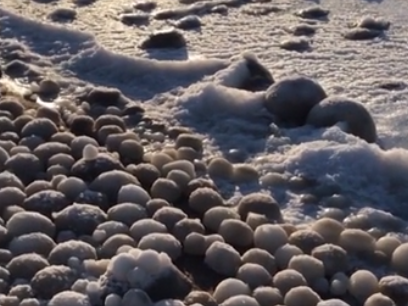Beach found covered in mysterious ‘ice eggs’
'You really need to find the right conditions for this to happen'

Your support helps us to tell the story
From reproductive rights to climate change to Big Tech, The Independent is on the ground when the story is developing. Whether it's investigating the financials of Elon Musk's pro-Trump PAC or producing our latest documentary, 'The A Word', which shines a light on the American women fighting for reproductive rights, we know how important it is to parse out the facts from the messaging.
At such a critical moment in US history, we need reporters on the ground. Your donation allows us to keep sending journalists to speak to both sides of the story.
The Independent is trusted by Americans across the entire political spectrum. And unlike many other quality news outlets, we choose not to lock Americans out of our reporting and analysis with paywalls. We believe quality journalism should be available to everyone, paid for by those who can afford it.
Your support makes all the difference.A Finnish beach has been covered by an unusual expanse of egg-shaped chunks of ice.
Risto Mattila, an amateur photographer, posted the image on Instagram with the caption “snow ball sea” after coming across the scene on Hailuoto Island.
“I was with my wife at Marjaniemi beach. The weather was sunny, about -1C and it was quite a windy day,” he told the BBC.
“There we found this amazing phenomenon. There was snow and ice eggs along the beach near the water line.”
It is “really rare” to get the mixture of geographical and meteorological conditions necessary to form these ice balls, Patrick Erikkson, an ice expert at the Finnish Meteorological Institute, told The Independent.
He explained when sea water is cooled down to freezing point, ice crystals can form near the surface and join together to form a sheet in deep water.
“If we are closer to shore, then these lumps start to roll,” Mr Erikkson said.
“When we have water and very cold air, they start growing and collecting more and more ice around them. They can get as big as footballs that way, rolling around in the shore line.”
Mr Mattilla, the photographer who stumbled across the ice balls on the beach, said the smallest ones were the size of eggs, while the largest were as big as footballs.
“That was an amazing view. I have never seen anything like this during 25 years living in the vicinity,” he told the BBC.
Mr Erikkson said: “You really need to find the right conditions for this to happen."
He said the “natural phenomenon” requires “a situation where the water has cooled down, a sea area in the right stage of freezing, the wind from a suitable direction generating the wave motion from the shore line and a shallow, smooth sea floor”.
In 2014, ice balls were seen in the US on the shoreline of Lake Michigan following a bout of sub zero temperatures.
Join our commenting forum
Join thought-provoking conversations, follow other Independent readers and see their replies
Comments